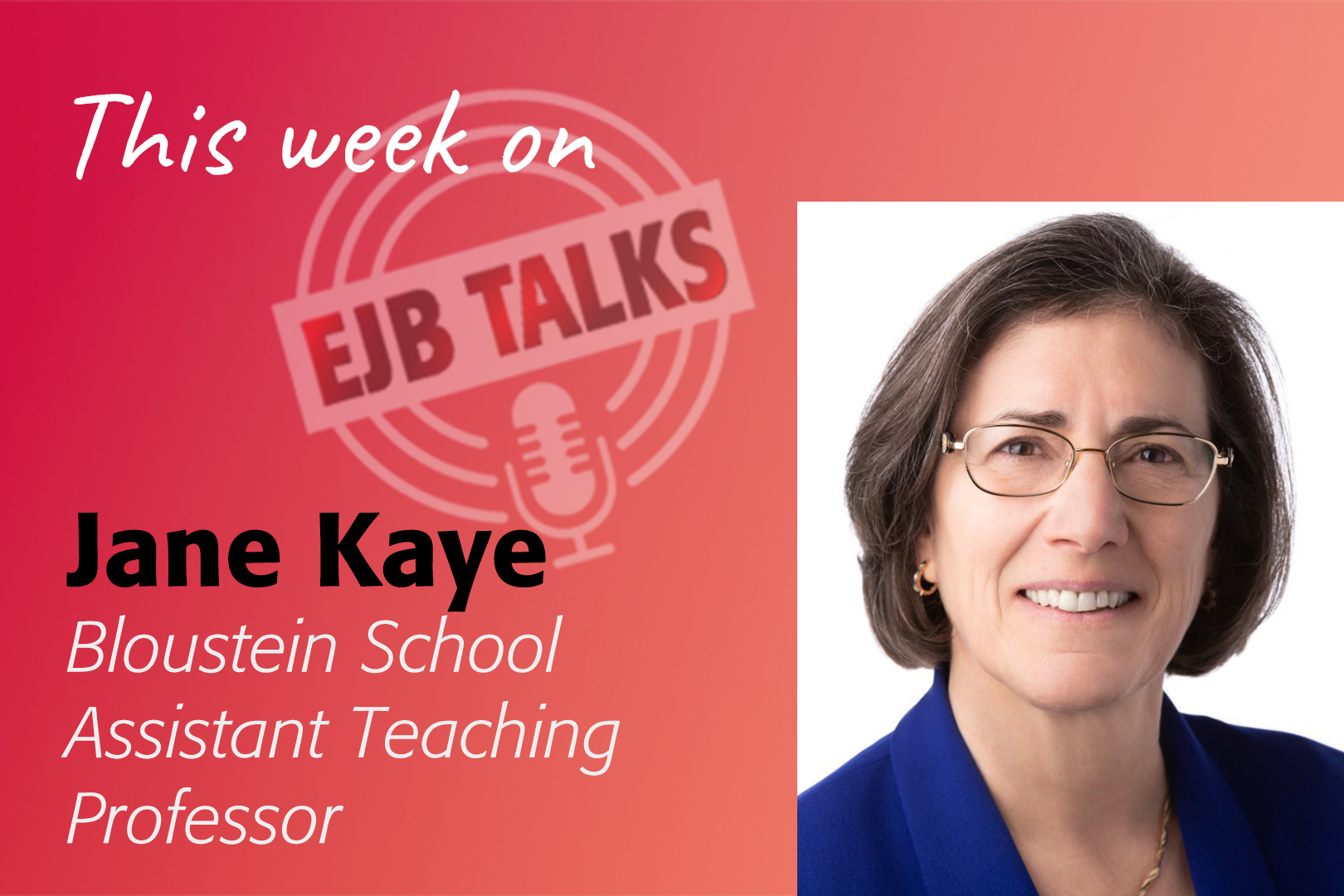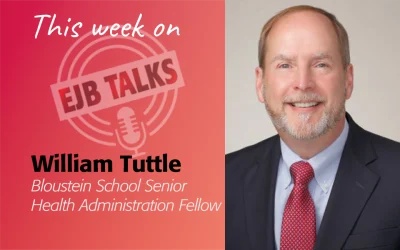Dean Stuart Shapiro talks about the path to a career in health administration with Assistant Teaching Professor Jane Kaye on EJB Talks this week. Professor Kaye shares her unconventional path to healthcare which began in art history. After working in various policy roles she went on to obtain an MBA, eventually becoming a hospital CFO. She discusses the complexities of hospital revenue cycle management and billing, noting how the U.S. healthcare system has evolved to become overly complicated for patients to understand. They also discuss the challenges of hospitals balancing patient care and financial operations. Professor Kaye closes with the reasons why healthcare administration remains an appealing career option for students, given the many opportunities available, and what she aims to teach students to help them succeed and make positive changes in the industry.
Transcript:
Stuart Shapiro
Welcome to EJB Talks. I’m Stuart Shapiro, the dean of the Bloustein School. And the purpose of this podcast is to highlight the work my colleagues and our alumni in the fields of policy, planning, and health are doing.
This season, we’re speaking with faculty and alumni. And today, I am speaking with Professor Jane Kaye, who teaches in our health administration program. Our Master’s in Health Administration recently debuted at a very impressive 32nd in the national rankings. It was just created in 2017. And it’s already rocketing to the top.
With that, welcome, Professor Kaye.
Jane Kaye
Thank you, Dean Shapiro. Thanks for having me.
Stuart Shapiro
Absolutely. So we always start with an origin story-type question, or I should say we almost always start. So let me ask you, why did you become interested in healthcare? And how did you get there? From what was not a career that started in healthcare?
Jane Kaye
Right. So I had a very circuitous route to health care. I’m from Massachusetts, I went to college in Philadelphia, and I studied History of Art. Why did I study that? I had no idea what I wanted to do. It was my first A, and I thought, Oh, I must be good at this. So I majored in History of Art. I went back to Boston, worked at an art gallery. Didn’t really like that. I was interested in policy. So I moved into a role at the state house as a legislative aide. And then I started working at state agencies.
And what I found in that work was that, I was drawn to the analytical work and budgets, and that the budgets is where a lot of decisions were being made. And I wanted to understand that process. But I didn’t love working in state agencies. I had great jobs and great bosses. But I knew that wasn’t where I would land. So I went back to school at night, much like our masters students, many of whom work during the day.I went back at night for a Master’s in Business Administration. That took me six years to complete.
Towards the end of my MBA, I moved to New Jersey and got a job in public accounting. So at this point, I’m now in my 30s. I now have one child, I have a second child, I’m still working, I’m still working towards my master’s. I still haven’t found my place. And a colleague of mine recruited me to a hospital to be the assistant controller. And when I landed in that hospital, Raritan Bay Medical Center. At that point, it’s the mid-90s, all the hospitals are independent. There are independent hospitals everywhere. I loved it there. I felt, finally, that I found my place. So it was very serendipitous that I made my way to healthcare. But luckily, I did. And I’ve been in healthcare ever since.
Stuart Shapiro
And it’s interesting that you came there by way of being interested in finance and budgeting and accounting. That’s not a typical path that people get to healthcare by.
Jane Kaye
It is not. And then as a finance and accounting person, my own path was very atypical. Most of my colleagues, CFOs in the state, they went to college at 18. They decided to be accounting majors. They studied accounting, they became CPAs, and they did accounting. I had this roundabout route, which made me a very unusual CFO in the state. And also, the first time I was CFO, there were maybe two women CFOs out of 90, maybe at that point. So everything about my journey is unusual.
Stuart Shapiro
So let’s talk about that CFO position. What does a CFO of a hospital need to worry about? I mean, I have guesses? But I’d like to hear from someone who’s lived through it.
Jane Kaye
Yeah. So I think the first and most important worry is collecting enough cash so the hospital can pay its bills and pay it’s payroll. And it sounds so simple. You provide services to patients, you send a bill to the insurance company, they pay it, everything’s great. But nothing could be more complicated than what we call the revenue cycle. Which is this series of steps that happen, that patients and administrators don’t even really know about.
Stuart Shapiro
Right.
Jane Kaye
It starts right from the minute that a patient makes an appointment. We start gathering health insurance information at that point of registration. Then we provide services and then we have to send the information to the coding department. They have to add all kinds of codes to tell the insurance company what we did. And we have to add charges, lands on a bill, you send it to the insurance company. Every single step along the way can go wrong. And then you finally get a bill to the insurance company and they don’t want to pay it. They think the services weren’t necessary. They think the hospital held the patient for too long, they should have discharged them. And a big fight happens. And meanwhile, the hospital is not getting paid. It could be 30, 60, 90 days. It could be a year of the hospital waiting to get paid.
Meanwhile, you’re paying salaries. You’re paying for patient care. You’ve got lots of supplies coming in that you have to pay for. And the money is being held up. And that is what makes being CFO of a hospital so complicated and so unique. You know, there’s no industry, Stuart, that operates like that at all.
Stuart Shapiro
Yeah, it is very… I used to teach health economics. I have some idea of this. But I will tell you, that you know, the bizarreness of the experience of being a patient, and seeing a bill. Where there’s one number that the hospital charges, there’s another number that the insurance company pays. Maybe the difference gets paid by someone else or maybe it never gets paid. But it’s utterly and totally inscrutable.
Jane Kaye
It is completely inscrutable. And the only people who understand it are people who work in the field. People who, like my colleagues. The finance side of the house will generally understand it. But it’s a mess, Stuart. The system is a mess. And I teach it.
Stuart Shapiro
((laughing))
Jane Kaye
And when I have to access healthcare myself, as an example, there is no way for me to know how much I’m going to be charged. How much the insurance company will allow? And what my out-of-pocket is going to be. It’s very difficult to know that upfront. It’s difficult for anyone to understand those bills. I completely agree.
Stuart Shapiro
So I’m sure it’s one of the first questions your students ask. Why is it like this?
Jane Kaye
Yeah, so I tell my students, it’s a mess. It’s a complete mess. It’s been cobbled together over decades. That’s all I can say. You know, originally, hospitals were paid, and reimbursed by the government. They spent $1, they were paid the $1. It was called cost reimbursement. It was great. And you didn’t worry in the hospital. Because you knew that you’d be made whole financially.
But Medicare decides no, we’re going to bundle things up. And we’re going to put in this thing called a “diagnostic related group.” And it’s going to be based on codes. So all of a sudden, all this coding becomes important. You’ve got specialized coders now who try to get the hospital, you know, the best code they can so that the hospital can make the most money. So Medicare–you know, we want Medicare to be a good steward of the taxpayers dollars. So Medicare creates a system that’s extremely complicated to navigate. And, you know, that’s as best as I can put it. And then it’s kind of grown from there. Where every payer has their own rules, their own benchmarks. It’s extremely complex.
Stuart Shapiro
Yeah, we talk about and you know, study bureaucracy and things like that. We talk about “kludges,” right? Everything, every part of the system, is a kludge to fix a prior problem. And before long, what you’ve got is, you’ve got this system which is–to use this the word again, inscrutable–and so Byzantine, and so paperwork heavy, that it no longer resembles what you started with.
Jane Kaye
That’s right. And it’s very difficult to administer. And yet there are many stakeholders in the process who benefit from the mess.
Stuart Shapiro
Right.
Jane Kaye
There are consultants who benefit. There’s vendors who helped the hospitals collect money. They benefit. You know, the American Medical Association owns… literally, has the trademark to some of these codes. They benefit. Even though their doctors don’t like this, the AMA benefits. You know, all the stakeholders have figured out how to make it work. But the system as a whole, as you just said, is Byzantine and bizarre. And this is what I teach my students.
Stuart Shapiro
When my parents were sick, I had to hire someone–and God bless the fact that I’m lucky enough to be able to do so–to change their insurance. I just couldn’t figure it out. I couldn’t figure it out. And I had nowhere near enough time to do that. And so I hired, you know, one of those consultants to do that.
Jane Kaye
Yup. So can you imagine, Stuart with your level of knowledge and education, that you couldn’t sort it out without help? How about somebody who has never had this opportunity for thoughtful education, and a thoughtful view of how bureaucracies work? They won’t even know where to begin? They won’t know. And it’s sad, you know?
Stuart Shapiro
Yeah, it is. It’s a very difficult situation. And because there are all these stakeholders who, as you noted, have a stake in it, it’s very hard to change as a result.
Jane Kaye
Exactly.
Stuart Shapiro
Let me ask you one more question about working at the hospital, because I’m because I’m curious. So you talked about, you know, the need to keep the lights on, if you will. And so how does the hospital balance that with its central mission, which is caring for patients?
Jane Kaye
Right. So the central mission is definitely caring for patients. And that has to be the focus. So financially, that is where the resources tend to go. And what that means is that, what I call the “back office functions,” like finance or human resources. These important functions that keep the hospital going. Are frequently underfunded. And rightly so at the expense of patient care, which needs to be the focus. So there’s always like a balancing act, between making sure patient care is reasonable. But acknowledging that money is needed throughout the organization to have the organization run effectively. It’s tough.
Stuart Shapiro
Yeah. It’s a huge challenge.
Jane Kaye
And, you know, I want to just mention this. Hospitals make what we call an operating margin, which is basically like the profit. They’ll make one 1% or 2%, meaning they bring in $100 of revenue, their profit is $1 or $2. If you look at a large, publicly traded company that we all know. Think of Apple, Amazon, Meta, like all these big companies. They keep $20, $25, maybe $30. No business runs as tightly in this way with profits that are barely there the way healthcare runs. Which is also what makes it challenging to continue patient care and balance patient care with all the other funding needs. There usually is just not enough money.
Stuart Shapiro
So given these challenges I can understand why there is a need for great health administrators. Why are students so excited about this career?
Jane Kaye
So they are excited, and I love this about our students. So I think the first thing is that healthcare is huge. You know, it’s almost a fifth of the economy. Something like 18% of the gross domestic product. It’s huge. And encompasses everything from a local substance use disorder provider in your community to Optum Health, which is a national integrated insurance company that owns doctors’ practices and pharmacy. And you’ve got CVS and Aetna in the same company. And then you’ve got these mega systems here in the state. We have Robert Wood Johnson Barnabas Health, we have Hackensack Meridian, we have many other systems.
There’s so many places for smart, talented people to go in healthcare. And I also think that we’re all touched by health care. Our students go to the doctor. If they have medical issues — and I hope they don’t, but if they do — they’re at the doctor’s office a lot. And they have family members who might have medical issues. So we’re exposed to this industry. And I think it really excites them to be part of something big and changing. And there’s a lot of change happening. And something that really touches people’s lives in a really profound way. You know, a lot of our students talk about experiences in their family, that perhaps were not ideal that have motivated them to come into this industry and try to make a change.
Stuart Shapiro
That’s great.
Jane Kaye
Yeah.
Stuart Shapiro
That really is. So what do you want your students to get out of your classes to get out of either their undergraduate studies in health administration or their Master’s in Health Administration?
Jane Kaye
I want them to be really excited and energized by the mess that we have. I want them to go out and figure out ways to make it better. And I want them to feel comfortable. That we’re giving them the basics that they need to be really fantastic employees, because there are fabulous careers in health administration. They know it, that’s why they have chosen this area. And I want them to go out and just blossom when they get out there. It’s exciting for me.
Stuart Shapiro
And hopefully exciting for the healthcare system in the longer run!
Jane Kaye
Boy, we hope so. Absolutely! (laughing)
Stuart Shapiro
(laughing) So you’ve come from hospitals to education, right? What surprised you?
Jane Kaye
Right? And you know, I didn’t finish my story about how I ended up at Rutgers. So my circuitous journey continues. And here I am. Now I’m an assistant teaching professor. And what surprises me most about teaching healthcare administration is how fabulous our students are. They are so engaged and so passionate and so eager to learn. And the diversity at Rutgers is truly amazing. And I I find that personally, very energizing. The students are fabulous here, Stuart. But you know that! I’m not telling you anything they don’t know.
Stuart Shapiro
Well, I couldn’t ask for a better note to end on! (laughing) Thank you very much, Jane, for coming on today.
Jane Kaye
Oh, Stuart, thank you for having me.
Stuart Shapiro
Also, thank you to Tamara Swedberg and Karyn Olsen, who make this podcast run. And we will see you next week with another talk from another expert at the Bloustein School. Until then, stay safe.




